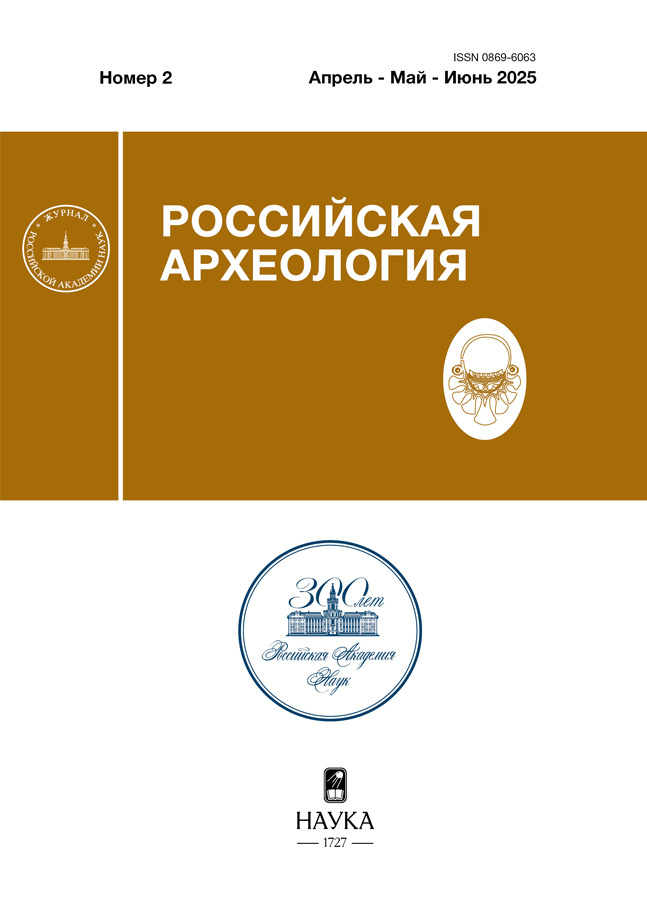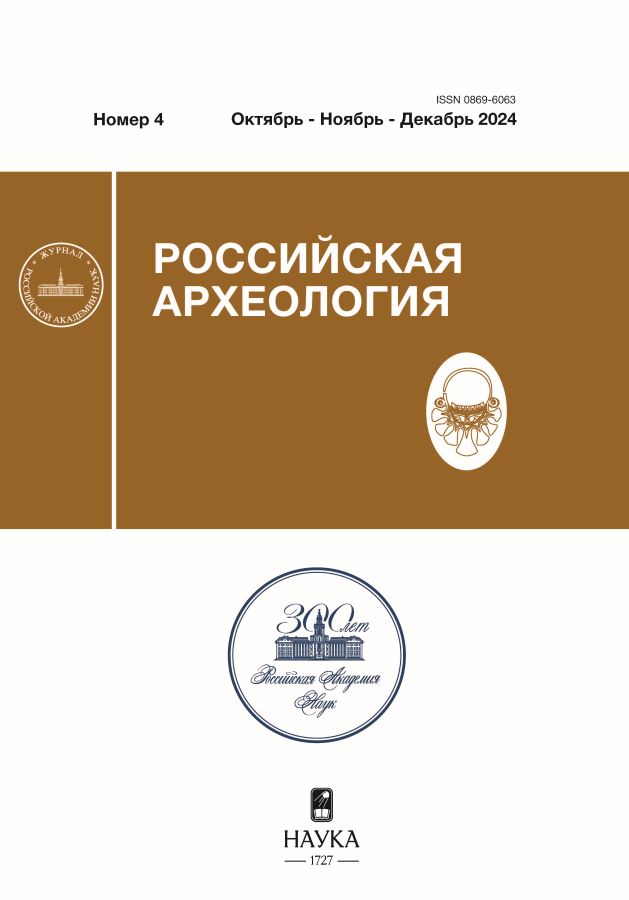Sources of non-ferrous metals in North-Eastern Rus in the 11th-13th centuries AD based on the results of lead isotopic analysis
- Authors: Merkel S.W.1, Zaitseva I.E.2, Chugaev A.V.3
-
Affiliations:
- Vrije Universiteit
- Institute of Archaeology of the RAS
- Institute of Geology of Ore Deposits, Petrography, Mineralogy and Geochemistry of the RAS
- Issue: No 4 (2024)
- Pages: 78-95
- Section: ARTICLES
- URL: https://ter-arkhiv.ru/0869-6063/article/view/655810
- DOI: https://doi.org/10.31857/S0869606324040068
- EDN: https://elibrary.ru/KJBFMY
- ID: 655810
Cite item
Abstract
The article discusses the results of lead isotope analysis of 43 non-ferrous metal objects from the 11th–13th centuries AD from rural sites of Suzdal Opolye and settlements in the Murom area. As a result of comparison of the obtained data with the available databases of lead isotope values of archaeological objects from various collections and ore samples, it was established that most of the copper-based alloy items were made of copper obtained in Westphalia and Saxony. Probably, it came to North-Eastern Rus via the Baltic. The lead of many low-melting ornaments comes from Polish deposits in the Krakow region. It seems that the use of the results of lead isotope analysis in metal objects is a promising direction in medieval metal studies opening up access to many previously unexplored aspects of medieval economic and cultural history.
Full Text
About the authors
S. W. Merkel
Vrije Universiteit
Author for correspondence.
Email: swmerkel@hotmail.com
Netherlands, Amsterdam
I. E. Zaitseva
Institute of Archaeology of the RAS
Email: izaitseva@yandex.ru
Russian Federation, Moscow
A. V. Chugaev
Institute of Geology of Ore Deposits, Petrography, Mineralogy and Geochemistry of the RAS
Email: vassachav@mail.ru
Russian Federation, Moscow
References
- Barnes I.L., Brill R.H., Deal E.C., Piercy G.V., 1986. Lead Isotope Studies of Some of the Finds from the Serçe Limani Shipwreck. Proceedings of the 24th International Archaeometry Symposium. Washington, DC: Smithsonian Institution Press, pp. 1–12.
- Bartels C., Klappauf L., 2012. Der Aufschwung des Bergbaus in der Zeit der Karolinger und Ottonen, die mittelalterliche Blüte und der Abschwung bis zur Mitte des 14. Jahrhunderts. Geschichte des deutschen Bergbaus, 1. Der alteuropäische Bergbau. Von den Anfängen bis zur Mitte des 18. Jahrhunderts. Münster: Aschendorff, pp. 111–238.
- Begemann F., Kallas K., Schmitt-Strecker S., Pernicka E., 1999. Tracing ancient tin via isotope analyses. The Beginnings of Metallurgy. Bochum: Deutsches Bergbau-Museum, pp. 277–284. (Der Anschnitt. Beiheft, 9).
- Bielicki K.H., Tischendorf G., 1991. Lead Isotope and Pb-Pb Model Age Determinations of Ores from Central Europe and their Metallogenetic Interpretation. Contributions to Mineralogy and Petrology, 106, pp. 440–461.
- Bode M., 2008. Archäometallurgische Untersuchungen zur Blei-/Silbergewinnung im Germanien der frühen römischen Kaiserzeit: Dissertation. Westfälischen Wilhelms-Universität Münster. Münster.
- Borón P., Rozmus D., 2014. Silver and lead production centre in southern Poland – between Bytom, Olkusz and Tarnowskie Góry in the Middle Ages. Research Problems. Acta rerum naturalium, 16, pp. 51–60.
- Chernyshev I.V., Vikent'ev I.V., Chugaev A.V. et al., 2008. Sources of the substance of the Ural pyrite deposits based on the results of high-precision MS-ICP-MS isotope analysis of galena lead. Doklady Akademii nau k [Reports of the Academy of Sciences], 418, 4, pp. 530–535. (In Russ.)
- Church S.E., Vaughn R.B., 1992. Lead-isotopic characteristics of the Cracow-Silesia Zn-Pb ores, southern Poland. Denver: US Department of Interior. 16 pl. (US Geological Survey Open File Report, 92–393).
- Constantinou G., 1982. Geological features and ancient exploitation of the cupriferous sulphide ore bodies of Cyprus. Early Metallurgy in Cyprus, 4000–500 B.C. Nicosia: Pierides Foundation, pp. 13–24.
- Drescher H., 1984. Glockenfunde aus Haithabu. Das archäologische Fundmaterial, IV. Neumünster: Wachholtz, pp. 9–62. (Berichte über die Ausgrabungen in Haithabu, 19).
- Durali-Müller S., 2005. Roman lead and copper mining in Germany: their origin and development through time, deduced from lead and copper isotope provenance studies: Dissertation zur Erlangen des Doktorgrades Der Naturwissenschaften. Johann Wolfgang Goethe-Universität. Frankfurt am Main.
- Durali-Müller S., Brey G.P., Wigg-Wolf D., Lahaye Y., 2007. Roman lead mining in Germany: its origin and development through time deduced from lead isotope provenance studies. Journal of Archaeological Science, 34, 10, pp. 1555–1567.
- Eniosova N.V., Singkh V.K., Stepanov A.M., 2018. Raw ingots of Novgorod jewellers. “ Neskonchaemoe leto”: sbornik statey v chest' Eleny Aleksandrovny Rybinoy [“Endless summer”: collected articles in honour of Elena Aleksandrovna Rybina]. Moscow; Velikiy Novgorod: Lyubavich, pp. 62–73. (In Russ.)
- Forshell H., 1992. The inception of copper mining in Falun. Stockholm.
- Gale N.H., 1999. Lead isotope characterization of the ore deposits of Cyprus and Sardinia and its application to the discovery of the sources of copper for Late Bronze Age oxhide ingots. Metals in Antiquity. Oxford: Archaeopress, pp. 110–121. (British archaeological reports. International Series, 792).
- Gale N.H., Stos-Gale Z.A., 1982. Bronze Age copper sources in the Mediterranean: a new approach. Science, 216, pp. 11–19.
- Gale N.H., Stos-Gale Z.A., Maliotis G., Annetts N., 1997. Lead isotope data from the isotrace laboratory. Oxford: Archaeometry data base 4, ores from Cyprus. Archaeometry, 39, 1, pp. 237–246.
- Gaydukov P.G., Oleynikov O.M., 2014. On the sources of raw materials on the Novgorod market of non-ferrous metals in the 15th century AD. Novgorod i Novgorodskaya zemlya. Istoriya i arkheologiya [Novgorod and the Novgorod land. History and archaeology], 28. Velikiy Novgorod: Novgorodskiy gosudarstvennyy ob"edinennyy muzey-zapovednik, pp. 263–266. (In Russ.)
- Godzik B., Woch M.W., 2015. History of mining in the Olkusz region. Przyrodnicza I hist oryczna wartość Olkuskiego Okręgu Rudnego. Cracow: W. Szafer Institute of Botany, Polish Academy of Sciences, pp. 29–36.
- Jülich S., 2006. Salzgewinnung und Blei am Hellweg. Bergbau im Sauerland: Westfälischer Bergbau in der Römerzeit und im Frühmittelalter. Münster: Verlag des Westfälischen Heimatbundes, pp. 45–57. (Schriften der Historischen Kommission für Westfalen, 20).
- Krahn L., Baumann A., 1996. Lead isotope systematics of epigenetic lead-zinc mineralization in the western part of the Rheinisches Schiefergebirge, Germany. Mineralium Deposita, 31, pp. 225–237.
- Krylasova N.B., 2018. On the development of A.M. Belavin’s ideas of commercial production of copper and its alloys in the medieval Perm area of the Cis-Urals. Trudy Kamskoy arkheologo-etnograficheskoy ekspeditsii [Proceedings of the Kama archaeological and ethnographic expedition], XIV. Perm': Permskiy gosudarstvennyy gumanitarno-pedagogicheskiy universitet, pp. 54–69. (In Russ.)
- Lehmann R., 2011. Archäometallurgie von mittelalterlichen deutschen Silberbarren und Münzen: Dissertation (Electronic resource). Leibniz Universität Hannover. URL: http://edok01.tib.uni-hannover.de/edoks/e01dh11/646461346.pdf.
- Makarov N.A., 2018. The oldest objects of Christian religious plastic art from the central regions of Northeastern Rus. U istokov i istochnikov: na mezhdunarodnykh i mezhdistsiplinarnykh putyakh: sbornik v chest' Aleksandra Vasil'evicha Nazarenko [At the origins and sources: on international and interdisciplinary paths: collected papers in honour of Aleksandr Vasilievich Nazarenko]. Moscow; St. Petersburg: Tsentr gumanitarnykh initsiativ, pp. 317–327. (In Russ.)
- Mecking O., 2020. The colours of archaeological copper alloys in binary and ternary copper alloys with varying amounts of Pb, Sn and Zn. Journal of Archaeological Science, 121, pp. 105–199.
- Merkel S., 2022. The elemental and lead isotope analysis of brass and other copper-based alloys from Viking Hedeby and High Medieval Schleswig. Haithabu 983–1066: Der Untergang eines dänischen Handelszentrums in der späten Wikingerzeit. München: Verlag Dr. Friedrich Pfeil, pp. 423–456. (Ausgrabungen in Haithabu, 19).
- Merkel S.W. Early to high medieval lead, pewter and tin from workshops and trading contexts in West and North Germany: elemental and lead isotope analysis. (In print).
- Merkel S.W., 2016. Silver and the Silver Economy at Hedeby. Raw Materials, Innovation, Technology of Ancient Cultures RITaK 2. Bochum: Verlag Marie Leidorf. 272 p. (Der Anschnitt. Beiheft, 33).
- Merkel S.W., Florkiewicz I., Jansen M., Bode M., Wołoszyn M., 2024. Evidence for Slavic lead mining and trade: Early Rus’ lead seals from Czermno and Gródek on the Polish Rus’ Border. Journal of Archaeological Science: Reports, 55, 104539.
- Miazga B., Duma P., Cembrzyński P. et al., 2022. Analytical studies on medieval lead ingots from Wrocław and Kraków (Poland): a step towards understanding bulk trade of lead from Kraków and Silesia Upland Pb-Zn deposits. Heritage Science, 10, 184.
- Mirnejad H., Simonetti A., Molasalehi F., 2011. Pb isotopic compositions of some Zn-Pb deposits and occurrences from Urumieh-Dokhtar and Sanandaj–Sirjan zones in Iran. Ore geology reviews, 39, 4, pp. 181–187.
- Molenda D., 2001. Polski ołów na rynkach Europy Środkowej w XIII–XVII wieku. Warszawa. 227 p.
- Orfanou V., Birch T., Lichtenberger A. et al., 2020. Copper-based metalwork in Roman to early Islamic Jerash (Jordan): Insights into production and recycling through alloy composition and lead isotopes. Journal of Archaeological Science: Reports, 33, pp. 102–119.
- Pedersen U., Andersen T., Simonsen S., Erambert M., 2016. Lead isotope analysis of pewter mounts from the Viking ship burial at Gokstad: on the origin and use of raw materials. Archaeometry, 58, pp. 148–163.
- Pernicka E., 2014. Provenance Determination of Archaeological Metal Objects. Archaeometallurgy in Global Perspective: Methods and Syntheses. Heidelberg: Springer, pp. 239–268.
- Pernicka E., Adam K., Böhme M. et al., 2011. Archaeometallurgical Research on the Western Central Iranian Plateau. Early Mining and Metallurgy on the Western Central Iranian Plateau. Mainz: Philipp von Zabern, pp. 631–688. (Archäologie in Iran und Turan, 9).
- Pernicka E., Begemann F., Schmitt-Strecker S. et al., 1997. Prehistoric copper in Bulgaria: Its composition and provenance. Eurasia Antiqua, 3, pp. 41–180.
- Pernicka E., Lutz J., Stöllner T., 2016. Bronze Age copper produced at Mitterberg, Austria, and its distribution. Archaeologia Austriaca, 100, pp. 19–55.
- Pollard A.M., Bray P., Cuenod P. et al., 2018. Beyond Provenance. New Approaches to Interpreting the Chemistry of Archaeological Copper Alloys. Leuven. 232 p.
- Rohl B.M., 1996. Lead isotope data from the Isotrace Laboratory, Oxford: Archaeometry data base 2, galena from Britain and Ireland. Archaeometry, 38, 1, рр. 165–180.
- Rybina E.A., 2001. Torgovlya srednevekovogo Novgoroda. Istoriko-arkheologicheskie ocherki [Trade of medieval Novgorod. Historical and archaeological studies]. Velikiy Novgorod: Novgorodskiy gosudarstvennyy universitet. 390 p.
- Schneider J., 1994. Geochemische Untersuchungen zur Genese von Buntmetallvererzungen in der Nordeifel: Diplomarbeit. Justus-Liebig-Universität Gießen. Gießen.
- Stacey J.S., Kramers I.D., 1975. Approximation of terrestrial lead isotope evolution by a two-stage model. Earth and Planetary Science Letters, 26, 2, pp. 207–221.
- Stos-Gale Z., 2004а. Lead-Isotope Analyses of Glass, Glazes, and Some Metal Artefacts. Serçe Limani. An Eleventh-Century Shipwreck, 1. The Ship and Its Anchorage, Crew, and Passengers. College Station: Texas A&M University Press, pp. 453–467.
- Stos-Gale Z., 2004б. Appendix 3. Lead isotope analyses of the lead weights from Birka, Sweden. Mellan Gåva Och Marknad: Handel, Tillit och Materiell Kultur under Vikingatid. Lund, pp. 324–331. (Lund Studies in Medieval Archaeology, 34).
- Stos-Gale Z.A., Gale N.H., Annetts N. et al., 1998. Lead Isotope Data the isotrace Laboratory, Oxford: Archaeometry Data Base 5, Ores from Bulgaria. Archaeometry, 40, pp. 217–226.
- Stos-Gale Z.A., Maliotis G., Gale N.H., Annetts N., 1997. Lead Isotope characteristics of the Cyprus copper ore deposits applied to provenance studies of copper oxhide ingots. Archaeometry, 39, pp. 83–123.
- Strassburger M., 2012. Middle-aged silver, copper and lead mining near Ramsbeck. Acta rerum naturalium, 12, pp. 31–44.
- Tylecote R., 1986. The Prehistory of Metallurgy in the British Isles. London: Institute of Metals.
- Vleeschouwer F. de, Fagel B., Cheburkin A. et al., 2009. Anthropogenic impacts in North Poland over the last 1300 years – A Record of Pb, Zn, Cu, Ni and S in an ombrotrophic peat bog. Science of the Total Environment, 407, pp. 5674–5684.
- Wagner T., Schneider J., 1999. Ore remobilisation related to sulphide-sulphosalt reactions in hydrothermal vein systems of the Dörnberg-Aurora (Ramsbeck) deposit, NW Germany: Evidence from small-scale Pb-isotopic studies. Mineral Deposits: Processes to Processing: Proceedings of the 5th biennial SGA meeting, London. Rotterdam: Balkema, pp. 995–998.
- Wajda S., Merkel S.W., Florkiewicz I. et al., 2024. Early medieval lead glass bangles from Czermno, Poland: results of elemental and lead isotopes analyses. Archaeometry, 66, 2, pp. 306–325.
- Yanin V.L., 1966. Finds of Polish lead in Novgorod. Sovetskaya arkheologiya [Soviet archaeology], 2, pp. 324–328. (In Russ.)
- Zientek C., 1998. Archäometallurgische Untersuchungen an ausgewählten Buntmetallfunden des Mittelalters aus Nordrhein-Westfalen und Niedersachsen: Dissertation. Johann Wolfgang Goethe-Universität. Frankfurt am Main.
Supplementary files


















